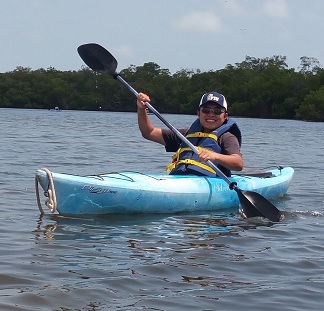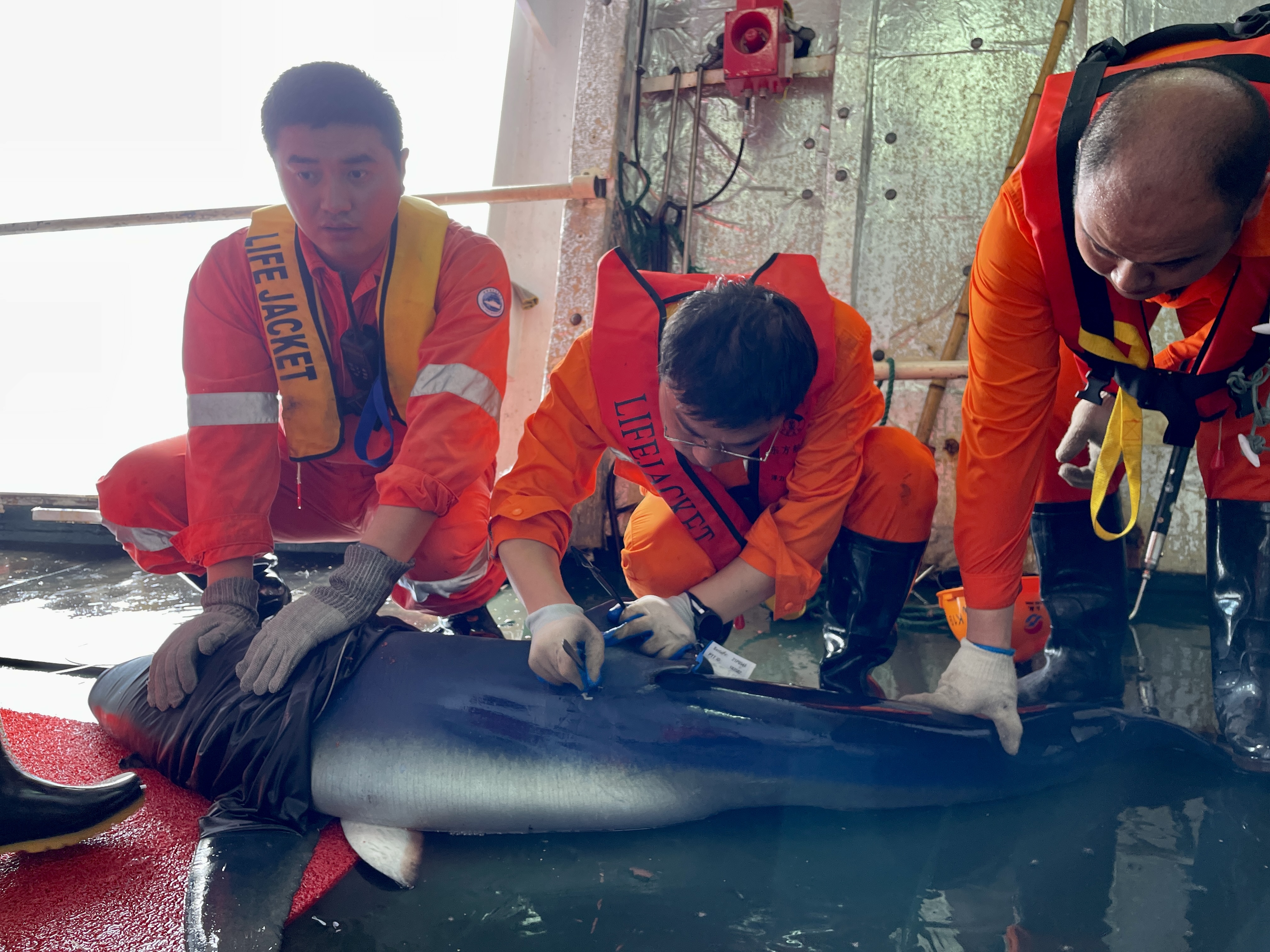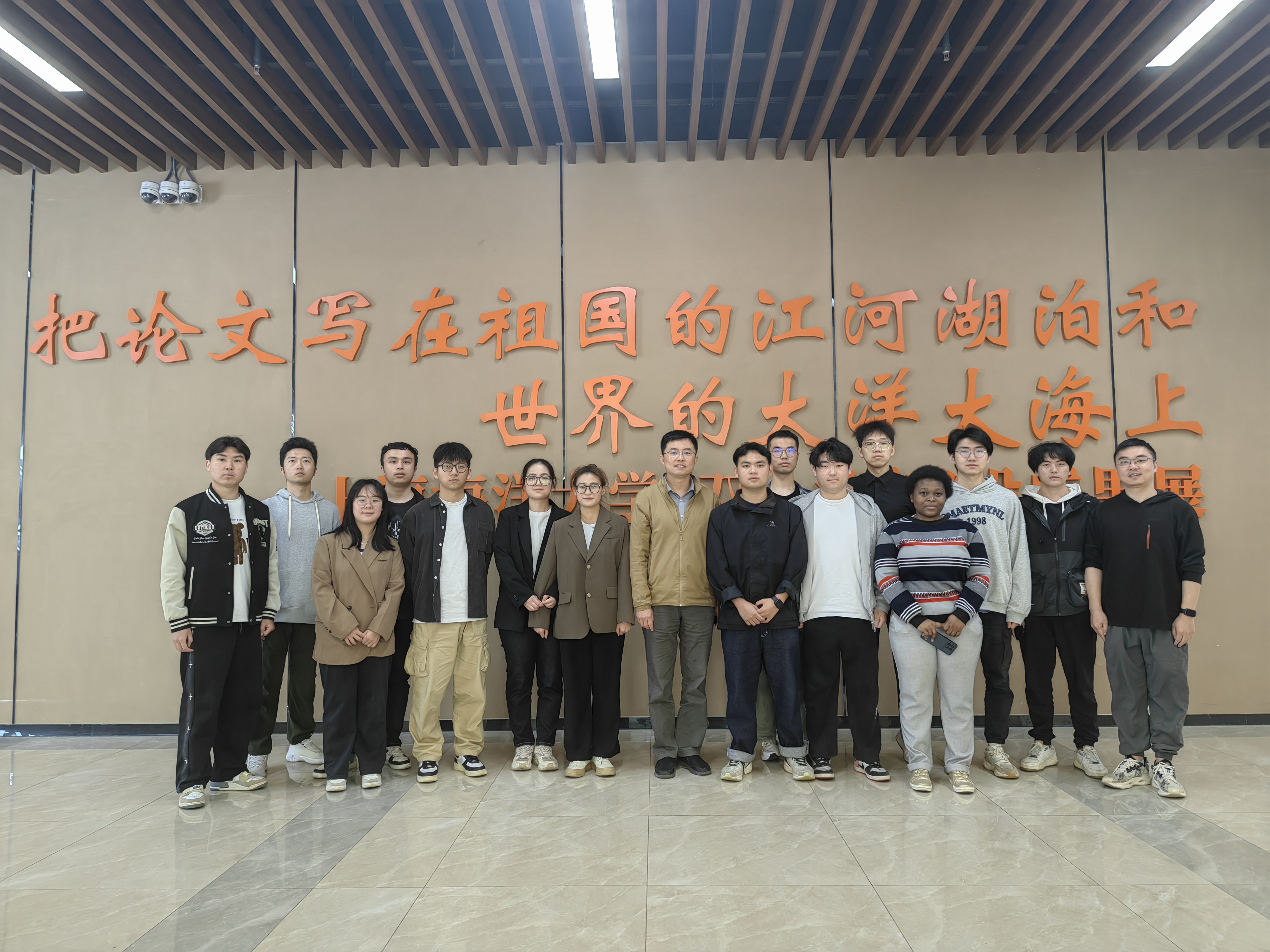
Yunkai Li (Google Scholar)
I am a professor at the Center for International Marine studies and the College of Marine Sciences at Shanghai Ocean University. My research interests include the ecology and evolution of sharks and rays, genomic analysis, stable isotope ecology and conservation biology of endangered species.
I received my Ph.D. in Aquatic Biology (2009) at East China Normal University, Shanghai, China. I was also a visiting Ph.D candidate to Yong Chen's Lab (supported by China Scholarship Council) at the University of Maine, Orono ME 04469, USA (2007-2008)
and a visiting scholar of Dr. Yuying Zhang and Dr. Michael R.Heithaus (supported by China Scholarship Council) at Florida International University, North Miami FL 33181, USA (2015-2016).
Honors and Rewards
(1) Professor of Special
Appointment (Eastern Scholar) of year 2022 by Shanghai Municipal Education Commission.
(2)
"Chen Guang" Scholar of the year 2010 by Shanghai Municipal Education Commission and Shanghai Education Development Foundation, China.
(3) "Haiyan" Scholar of the year 2014 by Shanghai Ocean University.
(4) 2018 Distinguished Teaching Award by Shanghai Ocean University.
Research Grants
(9) National Natural Science Foundation. #32573520. Drivers of Early-pregnancy Migration in Blue Sharks (Prionace glauca) in the Northwest Pacific: Insights from Satellite Tracking and Non-lethal Sampling (2026.1-2029.12). Lead PI. RMB.500,000.
(8) National Natural Science Foundation. #42276092. Mechanisms maintaining biodiversity of pelagic sharks and their coexistence with other apex predators in the Tropical Pacific (2023.1-2026.12). Lead PI. RMB.560,000.
(7) National Natural Science Foundation. #31872573. Ecological roles of pelagic sharks in the Tropical Eastern Pacific and their mechanisms of regulating ecosystem structure and functions (2019.1-2022.12). Lead PI. RMB.590,000.
(6) Natural Science Foundation of Shanghai. #17ZR1413000. The feeding ecology of pelagic sharks in the Eastern Pacific (2017.5-2020.4). Lead PI. RMB.200,000.
(5) National Natural Science Foundation. #41541042. The feeding ecology of jumbo squid in the Southeast Pacific based on the information in hard tissues.(2016.1-2016.12). Lead PI. RMB.180,000.
(4) National Natural Science Foundation. #41206124. The feeding habits and migratory environmental history of Jumbo squid (Dosidicus gigas) in the high seas of Chile using isotopic signature of gladius.(2013.1-2015.12). Lead PI. RMB.240,000.
(3) Ph.D. Programs Foundation of Ministry of Education of China. The feeding habits and migratory environmental history of Jumbo squid (Dosidicus gigas) in the high seas of Chile using isotopic signature of gladius.(2013.1-2015.12). Lead PI. RMB.40,000
(2)
"Chen Guang" project. Ecological modeling on the identification and mechanisms of the keystone species in Lake Taihu. (2011.1-2013.12). Lead PI. RMB 60,000.
(1) Innovation project.
Ecological modeling on the identification and mechanisms of the keystone species in eutrophic lakes of China.(2011.1-2013.12). Lead PI. RMB 80,000.
Peer-review
(1) Advisory editor. Environmental Biology of Fishes .
Publications
2025
(40) Zhang B, Feng Y, Lv M, Jia L, LiaoY, Xu X, Meyer A, Sun J, Fan G, Li Y, Zhang Y*, Zhao N*, Li Y*, Bao B*. 2025. Adaptive loss of shortwave sensitive opsins during genomic evolution in cartilaginous fish. Nature Communications, 16, 7684 (PDF download).
(39) David M, Ngando NE, Chen X, Li Y*. 2025. Insights into the trophic ecology of the slendertail lanternshark, one of the smallest shark species: A multi-tracer analysis of dietary habits and trophic role in East China sea food webs. Marine Ecology Progress Series, (https://doi.org/10.3354/meps14953).
(38) Ding Y, Li Z, David M, Li Y*. 2025. Trophic ecology of the longnose lancetfish based on stable isotope values (δ13C and δ15N), mercury concentrations and stomach contents in the tropical western Pacific Ocean. Marine Biology, 172, 155 (PDF download).
(37) David M, Ngando NE, Shen Y, Li Y*. 2025. Deciphering Age, Growth, and Maturity Patterns in one of the smallest but data-deficient shark species, Slendertail Lanternshark (Etmopterus molleri) from the East China Sea. Journal of Fish Biology, (PDF download).
(36) Chen X, Li Z, Mboglen D, Li Y*. 2025. Trophic partitioning and mercury accumulation in deep-sea fishes of the East China Sea. Deep-Sea Research Part I, 218, 104473 (PDF download).
(35) Zhang B*, Pethybridge H, Li Y. 2025. Mercury bioaccumulation and biomagnification in mesopelagic biota. Marine Pollution Bulletin, 218, 118209 (PDF download).
2024
(34) Feng Z, Li N, Chen X, Li Y, Cao J, Yu W*. 2024. Nonstationary response of commercially pelagic species in the Humboldt current ecosystem to climate variability. Reviews in Fish Biology and Fisheries, https://doi.org/10.1007/s11160-024-09890-y (PDF download).
(33) Zhang B*, Pethybridge H, Sutton C, Virtue P, Li Y. 2024. Total mercury concentrations in Tasman Sea mesopelagic fish: Exploring biotic and abiotic drivers. Marine Pollution Bulletin, 206: 116676 (PDF download).
(32) Gong Y*, Gao H, Guo Z, Huang X, Li Y*, Li Z, Du C, Wu F. 2024. Uncovering the global status of plastic presence in marine chondrichthyans. Reviews in Fish Biology and Fisheries, https://doi.org/10.1007/s11160-024-09877-9 (PDF download).
(31) Shen Y, Hussey NE, David M, Wu F, Li Y*. 2024. Vertebral microchemistry as an indicator of habitat use of the oceanic whitetip shark Carcharhinus longimanus in the central and eastern Pacific Ocean. Journal of Fish Biology, 104 (6): 1732-1742 (PDF download).
(30) David M, Gong Y*, Guo Z, Nola DN, Li Y*. 2024. First report of plastic and non-plastic microparticles in stomach of slandertail lantern shark and shortspine spurdog from the edge of East China Sea. Marine Pollution Bulletin, 204: 116531 (PDF download).
(29) Li Z, Chen Z, Costa-Pereira R, Hussey N, Zhang Y*, Li Y*. 2024. Isotopic trajectories and interspecific niche partitioning in tropical pelagic sharks. Global Ecology and Conservation, 49: e02772 (PDF download).
(28) Guo Z, Gong Y*, Li Z, Shen Y, Li Y*. 2023. Lipid-extracted muscle and liver tissues: Can they reveal mercury exposure of pelagic sharks? Chemosphere, 340: 139873 (PDF download).
2023
(27) Li Z, Pethybridge H, Wu F*, Li Y*. 2023. Mercury bioaccumulation in thresher sharks from the eastern tropical Pacific: influences of body size, maturation stage, and feeding habitat. Science of the Total Environment, 872: 162248 (PDF download).
(26) Shen Y, David M, Gong Y, Wu F* and Li Y*. 2023. Effects of ethanol storage and lipid extraction on stable isotope compositions of twelve pelagic predators. Frontiers in Marine Science, 10:1118013. doi: 10.3389/fmars.2023.1118013 (PDF download)
2022
(25) Huang X, Gao H, Li Z, Wu F, Gong Y*, Li Y*. 2022. Microplastic contamination and risk assessment in blue shark (Prionace glauca) from the eastern tropical Pacific Ocean. Marine Pollution Bulletin114138 (PDF download)
(24) Li Z, Pethybridge H, Gong Y*, Wu F, Dai X, Li Y*. 2022.Effect of body size, feeding ecology and maternal transfer on mercury accumulation of vulnerable silky shark Carcharhinus falciformis in the eastern tropical Pacific. Environmental Pollution 119751 (PDF download)
(23) Xu M, Pethybridge H, Li Y*. 2022. Trophic niche partitioning of five sympatric shark species in the tropical eastern Pacific Ocean revealed by multi-tissue fatty acid analysis. Environmental Research 113828 (PDF download)
(22) Gao X, Gong Y, Chen X, Li Y*. 2022. Dietary shifts and niche partitioning throughout ontogeny reduce intraspecific competition in a pelagic generalist predator. Marine Ecology Progress Series, 692:81-97 (PDF download)
(21) Li Z, Hussey NE, Li Y*. 2022. Quantifying maternal transfer of trace elements and stable isotopes in the endangered pelagic thresher shark (Alopias pelagicus). Chemosphere, 300: 134614 (PDF download)
(20) Shen Y, Gong Y, Wu F, Li Y*. 2022. Retrospective stable isotopes of vertebrae reveal sexual ontogenetic patterns and trophic ecology in oceanic whitetip shark, Carcharhinus longimanus. Ecology and Evolution, DOI: 10.1002/ece3.8452 (PDF download)
2021
(19) Gong Y*, Wang Y, Chen L, Li Y*, Chen X, Liu B. 2021. Microplastics in different tissues of a pelagic squid (Dosidicus gigas) in the northern Humboldt Current ecosystem. Marine Pollution Bulletin https://doi.org/10.1016/j.marpolbul.2021.112509 (PDF download)
2020
(18) Gong Y, Li Y*, Chen X. Yu W. 2020. Trophic Niche and Diversity of a Pelagic Squid (Dosidicus gigas): A Comparative Study Using Stable Isotope, Fatty Acid, and Feeding Apparatuses Morphology. Frontiers in Marine Science, 7:642 doi: 10.3389/fmars.2020.00642 (PDF download)
2018
(17) Bird C, .... Li Y,...... Trueman C. 2018. A global perspective on the trophic geography of sharks. Nature Ecology & Evolution 2: 299–305. https://doi.org/10.1038/s41559-017-0432-z (https://www.nature.com/articles/s41559-017-0432-z) (PDF download)
From Sina news: http://tech.sina.com.cn/d/a/2018-02-05/doc-ifyreyvz9090194.shtml (in Chinese).
(16) Gong Y, Ruiz-Cooley RI, Hunsicker ME, Li Y*, Chen X. 2018. Sexual dimorphism in feeding apparatus and niche partitioning in juvenile jumbo squid Dosidicus gigas. Marine Ecology Progress Series, 607: 99-112. (PDF download)
(15) Gong Y, Li Y*, Chen X, Gao X, Chen L. 2018. Gladius growth pattern and increment of jumbo squid (Dosidicus gigas) in the tropical Pacific Ocean. Aquaculture and Fisheries, 3: 156-162. (PDF download)
(14) Gong Y, Li Y*, Chen X, Chen L. 2018. Potential use of stable isotope and fatty acid analyses for traceability of geographic origins of jumbo squid (Dosidicus gigas). Rapid Communication in Mass Spectrometry, 32: 583–589.(PDF download)
(13) Gong Y, Chen X, Li Y*, Fang Z. 2018.Geographic variations of jumbo squid (Dosidicus gigas) based on gladius morphology. Fishery Bulletin,116: 50-59. (PDF download)
2017
(12) Li Y, Gong Y, Zhang Y, Chen X*. 2017. Inter-annual variability in trophic patterns of jumbo squid (Dosidicus gigas) off the Exclusive Economic Zone of Peru, implications from stable isotope values in gladius. Fisheries Research,187: 22-30. (PDF download)
(11) Li Y, Zhang Y, Xu J, Zhang S*. 2017.Spatial variations in food web structures with alternative stable states: evidence from stable isotope analysis in a large eutrophic lake. Chinese Journal of Oceanology and Limnology. (PDF download)
2016
(10) Li Y*, Zhang Y, Dai X. 2016. Trophic interactions among pelagic sharks and large predatory teleosts in the northeast central Pacific. Journal of Experimental Marine Biology and Ecology, 483: 97-103. (PDF download)
(9) Li Y*, Hussey N, Zhang Y. 2016. Quantifying ontogenetic stable isotope variation between dermis and muscle tissue of two pelagic sharks. Aquatic Biology, 25: 53-60. (PDF download)
(8) Li Y, Zhang Y, Hussey N, Dai X*. 2016. Urea and lipid extraction treatment effects on δ15N and δ13C values in pelagic sharks. Rapid Communication in Mass Spectrometry, 30 (1): 1-8. (PDF download)
2015 and past
(7) Li Y, Zhang M. 2015. Ontogenetic changes in isotopic signatures of an omnivorous fish (Cultrichthys erythropterus) in East Lake Taihu, China. Chinese Journal of Oceanology and Limnology, 33(3): 725-731. (PDF download)
(6) Li Y, Gong Y, Chen X, Dai X, Zhu J*. 2014. Trophic ecology of sharks in the mid-east Pacific Ocean inferred from stable isotopes. Journal of Ocean University of China,13(2): 278-282. (PDF download)
(5) Zhang Y*, Li Y, Chen Y. 2012. Modeling the dynamics of ecosystem for the American
lobster in the Gulf of Maine. Aquatic Ecology, 46: 451-464. (PDF download)
(4) Li Y*, Zhang Y. 2012. Fishery impacts on the East China Sea Shelf ecosystem for 1969-2000. Helgoland Marine Research, 66: 371-383. (PDF download)
(3) Li Y, Chen Y, Olson D, Chen L*. 2010. Changes in the trophic interactions and the community structure of Lake Taihu (China) ecosystem from the 1960s to 1990s. Aquatic Ecology, 44: 337-348. (PDF download)
(2) Li Y, Chen Y, Olson D, Chen L*. 2009. Evaluating ecosystem structure and functioning of the East China Sea Shelf ecosystem, China. Hydrobiologia, 636: 331-351. (PDF download)
(1) Li Y, Olson D, Chen Y, Chen L*. 2009 .Ecosystem structure and functioning of Lake Taihu (China) and the impacts of fishing. Fisheries research, 95: 309-324. (PDF download)




